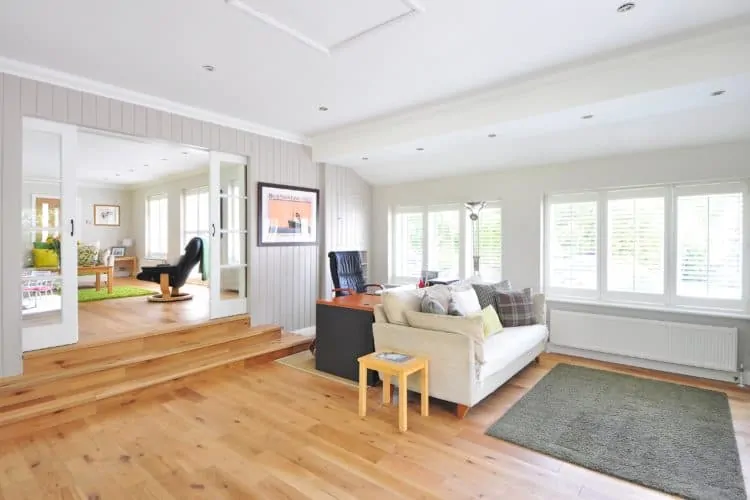
Home Extensions: What You Need to Know
Extending your home is a popular way to add space without the hassle of moving to a brand new house. And although home extensions are considerably less stress (and cost) than executing a full move, there are a lot of moving pieces and components that should be thoroughly researched. From the the planning process, to costs, design work and more, here’s what you need to know about home extensions.
Why Should You Extend Your Home?
There are lots of reasons to extend your home. Whether you want to create more space, add value to your investment, or just generally improve the comfort and aesthetic of your home, a house extension provide an attractive alternative to moving. “‘The increasing cost and hassle of moving combined with uncertainty in the property market makes staying put an attractive prospect,’ says Hugo Tugman, co-founder of Architect Your Home. ‘Many properties have untapped potential, and renovations can make a home more enjoyable to live in as well as adding to its market value’” (Ideal Home).
Here are some other benefits.
Save Time & Money
Simply put, moving is expensive. Between the actual cost of the sale (hiring a realtor, putting down a deposit, paying closing costs), the process and expenses associated with moving, and all the stress that comes with trying to sell your existing home, the process is taxing. Putting that money and effort towards expanding your home with an extension will save you more than just costs.
Increase Your Home’s Value
Not only will you save money in the short term, but home extensions are a great way of adding value to your home’s worth! Especially if you go the extra mile to craft an extension that truly complements your home’s design and improves the overall aesthetic, you can expect an increase in the market worth of the home (oftentimes just based on the increase in square footage alone). That’s not to say that there won’t be a significant investment upfront – most home extensions costs are recovered at the point of sale, so you need to be prepared to wait for your investment to pay off, if it’s ROI you’re after.
The Opportunity to Create the Home of Your Dreams
Home extensions are an excellent way to further hone your house into the home of you dreams. By moving forward with a home extension, you can design and build this new space exactly the way you want to, and even get input from your family on what they like to make it a project that benefits the entire household.
Still looking for more reasons to get a room addition? Check out our blog post.
Cost of Home Extensions
Like any major home improvement, the costs of home extensions are significant. Based off the most recent data, the national average for building a home addition or extensions is about $42,000, with the range extending from $21,000-$65,000. Although, some extensions have been reported to have cost less than $10,000.
So, if you are not willing or able to invest a minimum of $10-20,000 on a home extension, you may want to push back your project.
How to Finance Your Home Extension
The good news for inspiring home-renovators is that there is no shortage of options when it comes to borrowing money to finance your extension. Especially in today’s day and age, the financial landscape has become one that favors borrowers over savers.
If you need to borrow the money to finance your home extensions, your best options are:
- Credit card: If you need to borrow thousands rather than tens of thousands for your work, an interest-free credit card is a good choice.
- Loan: Personal loans of up to around $35,000 are suited to smaller projects. The only drawback with a loan, of course, is thay payments must be made consistently and in a timely manner.
- Remortgage or secured loan: If you are borrowing more than $35,000 you may need to remortgage your home or take our a secured loan against your home. Many banks and associations offer “Home Improvement Loans” for this very reason.
What Part of My Home Should I Expand?
Once you’ve done your research on whether or not a home extension may be a good fit for your unique situation and financial standing, one of the obvious questions that comes next is, “What part of my home should I expand?”
When it comes down to it, there are really two ways you can go with your home extension: building out or building up.
Building Out
The majority of home extensions are horizontal – meaning they increase the footprint of the ground-floor level of the building. That’s largely because so many additions are first-floor additions — whether you’re expanding the kitchen, adding a family room, or simply live in a one-story home.
Build out extensions are popular because they are easier to install – the process typically involves less disruption to the existing space because you’re not supporting the new space over the existing structural framing or foundation.
The disadvantage of “building out” is that, of course, that extra space has to come from somewhere – usually your yard.
Building Up
“Building up” is the other option for how to add room extensions, and there are many ways to execute this. You can add another story onto a one-story home, you can expand an existing top floor by installing large dormers, or you could add living space above an existing garage, porch, sunroom or other one-story wing.
Before you opt for a “building up,” make sure you research local codes in your area. Many towns limit the allowable height for houses, which can be an issue when building up.
Steps for Planning a Home Extension
Once you have an idea of the type of home extension you’d like to forward with, the next phase is to familiarize yourself with the actual process and moving forward with a home extension. Here are the steps to start planning a home extension.
1. Determine Your Property Lines
Before getting too deep into planning the details of your home extension, the first step is to determine where your home addition can feasibly go. Property lines will be a huge contributor to this decision, so locate your property lines and develop a plot plan which would include your home, landscaping and the location of the utilities.
Property lines are especially important to consider because of how they may affect your neighbors. Many cities have local codes that restrict how close you can build to your neighbor’s property, so you will definitely want to figure out this information sooner rather than later.
2. Finalize Budget
Finalizing your budget and how much you can afford to spend on your home extension project is a step that’s crucial to make in the early stages of planning. Home extensions (and all home remodeling projects) are notorious for having unplanning costs arise during the build phase, so nailing down a budget early on will help prevent more headaches and stress.
Plan a preliminary budget of how much you are comfortable spending, and add in anywhere from $10-20,000 in “padding” costs, especially if you live in an expensive area of the country or have heavy sloping. If your addition is small or will have relatively few bells and whistles, take off some costs.
Once you have an idea of your budget, then reach out to contractors (and architects) to start gathering bids. Plan to get bids from at least five contractors so you can get a good sense of price range and talent.
Why Use An Architect?
Although at first hearing it, hiring an architect may seem like an extraneous cost, In most cases, architects will be a necessary hire for your extension project.
Think of it this way: Contractors specialize in building, and architects specialize in designing. Going straight to a contractor means you are skipping the crucial design stage, and putting a humongous burden on your contractor.
By using an architect, you’ll end up with a home that’s right for you and that you’ll love living in.
The design of your home extension is worth the investment. A poorly designed extension can actually do more harm than good to your design aesthetic and eventual selling price.
Furthermore, you can hire an architect to help you manage all of the building process, including “helping you secure planning consent and building regulation certification, finding a suitable builder, monitoring progress, standards and safety on site, and overseeing construction to completion” (Ideal Home). When it comes to deciding where to spend your extension budget, a good architect can be worth their weight in gold.
3. Develop the Design
After taking a solid look at the structure and floor plan of your home, and choosing an architect or designer, the next stage is a fun one: developing a design and plan that will work perfectly in your home.
Home Extension Ideas Example
One of the most exciting aspects of planning a home extension is debatably one of the most overwhelming: the design. Here are some home extension ideas examples to give you some inspiration.
Flooring
When planning your extension, the flooring will be a huge component of the aesthetic and a major design decision. Whether you are building a kitchen, dining room, living room or all three in one open plan setting, here are some flooring ideas to get you inspired.
A trend that’s become very popular, especially in colder climates, is installing heated floors in your home extension. Not only do heated floors provide the comfort of making your feet feel all warm and toasty, but they are also efficient way to heat your home. Underfloor heating is also highly versatile and can lie underneath a number of different types of flooring such as stone, ceramic, terracotta, timber, some laminates and even carpet.
Laminate flooring is another increasingly popular choice for homeowners making renovations. This is because laminate, specifically engineered wood flooring, offers the benefit of looking like top-of-the-line true wood floors, but also being water-resistant and highly durable – an excellent investment for the long haul in your home.
Room Design
Room design itself can be a struggle for homeowners to ideate as they begin the home extension planning process. Here are a few extension room design ideas to inspire you and your design team.
High or vaulted ceilings are a classic, elegant option for room extensions. High ceilings can transform the way a room feels — even if you opt for less of a square footage extension, high ceilings tend to help make rooms look bigger than they actually are. Plus, vaulted ceilings offer maximum shock value. When pulled off well, the look can be stunning.
One trend that’s gained popularity amongst female homeowners in recent years is the idea of a “she-shed.” As explained by Country Living, “More and more ladies are staking claim to backyard sheds as a little place to call their own, whether it be for gardening or just somewhere to curl up with a good book.” If you’re envisioning your home extension to serve as an office or relaxation room, then perhaps a “she-shed” or other back-house type option may be a great choice for you.
4. Create the Plans
The last step before work on your home extension begins is to have detailed descriptions of the materials and the scope of the work to be done.
Although your contractor can certainly help you with this, it’s smart to make an initial list of desired materials on your own – anything from flooring to fixtures to paint. Be sure to also include first, second, and third choices, so you end up getting something you actually like if your first choice isn’t available, or you end up needed to cut costs in materials.
There’s a lot of work and planning involved in home extensions, but the end result can be something beautiful, economical, high-value and truly unique for you and your family.










